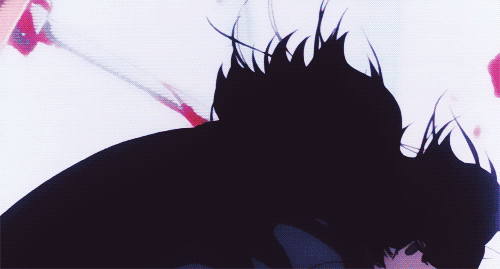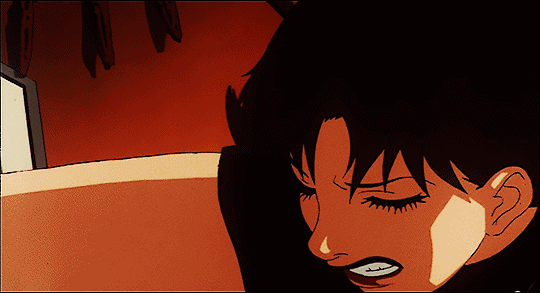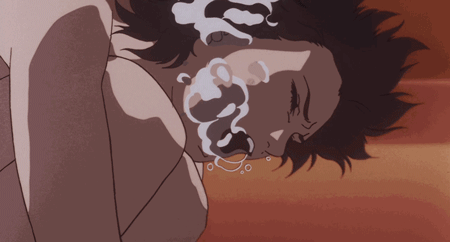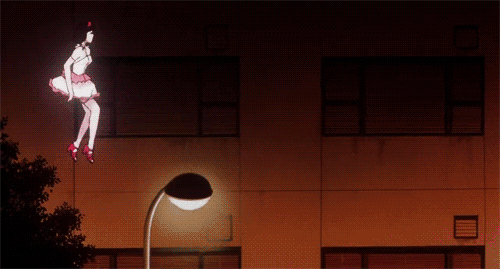An exploration of Perfect Blue(1997), directed by Satoshi Kon, Japanese and Asian society, and women in film.
Don't wanna be here? Send us removal request.
Text
Perfect Blue (1997): An Extreme, Yet Relatable Depiction of Female Rage (Aditi)

(image description: Mima at her lowest, killing her attacker, contrasted with an image of Mima smiling on a screen)
The film Perfect Blue examines through its’ protagonist, Mina, a young aspiring starlet, taboo topics such as female mental health and self-expression within Japanese society. The concept of “wa”, meaning harmony, is incredibly important to Japanese social interaction: people often engage in conflict avoidance, hiding negative emotions and opinions in order to preserve “wa”(Carosi, phmuseum). Additionally, Japan, compared to other high-income countries, has a higher stigma towards mental health: “the proportion of mental health service use by all persons and those with CMD [common mental disorders] was lower in Japan compared to most high-income countries from the 2000s to the 2010s”, and many within the country believe that having a mental health issue is “shameful and signifies a lack of willpower” (Kirk, Borgen Project). In addition to the stigma of expression of emotions and mental health, Japanese women also face high rates of misogyny and sexual violence in the workplace and in public. Research has reported that at least 75% of Japanese women have been groped, most often in public transportation (Guevara, Asian Media). However, these assaults are rarely reported or talked about, with victims taking personal responsibility for preventing these attacks by covering themselves with various preventative measures. These cultural norms coupled with violent misogyny create an environment where the expression of these frustrations are seemingly impossible to communicate without seeming “difficult”.

(image description: Mima breaking down in her room)
Satoshi Kon explores these topics in depth in his film, as Mima faces many inappropriate interactions with male writers, producers, and photographers as well as extreme advances from obsessive male fans, but never publicly confronts them. In public, Mima is always smiling and acting in a fairly calm manner, even as her mental state increasingly unravels due to the abuse of the industry as well as the actions of her stalker and manager/impersonator, Rumi. The few times she dissociates (or even hallucinates) during work, she immediately bows to her cast members and the director and apologizes profusely. However, in private Mima breaks down severely, having severe fits of destruction, screaming, panic attacks, and even hallucinations. For instance, after filming a scene in which she plays a stripper violently sexually assaulted by her audience, she continues to smile in public, thanking people for the acting opportunity. In her room however, she completely breaks down, becoming destructive and curling into her bed, sobbing uncontrollably and crying out “of course I didn’t want to do it”. This recurs frequently in the movie, as Mima is taken advantage of by a creepy photographer as well, and her agency does nothing to protect her from her stalker nor the men in the industry, and she is unable to assert herself, choosing to be pleasant in order to move ahead in her career. Additionally, Mima hides the symptoms of what may likely be schizophrenia or PTSD, her panic attacks and hallucinations, from those around her, finding private places to break down or going non verbal and apologizing when she experiences a hallucination. Satoshi Kon uses Mima as a vehicle for the choices Japanese women make everyday: to speak up about the things that upset them or play along silently in order to not be deemed a problem.

(image description: Mima screaming under water after nude pictures of herr were published. She is screaming "bastards!")
While the film is a commentary on sexism and mental health in Japanese society, the film also has a cult following in the West. In the last two years, Perfect Blue has made a comeback on social media. Aestheticized GIFs of the movie’s beautiful cinematography have become popular, and many young women dressed as Mima, the film’s protagonist, for halloween costumes. Many users have also commented how they relate to Mima as she descends into madness throughout the course of the film, becoming more unhinged in her expressions of sadness, anger, and frustration. The film makes her breakdowns deeply relatable because Mima never publicly expresses these emotions despite her deteriorating mental state: these breakdowns are private or channeled into her work as an actress. While the events that cause these breakdowns are extreme, ranging from her manager being a serial killer to sexual assault, these emotions are relatable to even those who haven’t experienced these things: women are taught from an extremely young age that politeness is valued over more “unpleasant emotions,” like anger or frustration. Expressing these emotions leads to being labeled a “bitch,” and deemed aggressive or unpleasant to be around.



(Image 1: Mima on the train, experiencing a hallucination. Image 2: Mima filming a graphic assault scene as a stripper. Image 3: Mima's hallucination of her ex-idol self, leaping around town. These images are a few snippets of the beautiful cinematography of the movie)
Naturally, the discussion of the film within a modern context has led to discourse over its content: does the film overly romanticize suffering? The film’s stunning visuals and cinematography are the primary reason that it has regained popularity, with people posting and taking inspiration from beautiful scenes of Mima at her worst: covered in blood, having panic attacks, and breaking down. However, is the aestheticization of mental illness and hysteria a result of the objectification of the female body, including the emotions women experience? And another question: would people be able to stomach this delve into the darkest, repressed parts of a woman’s psyche if it weren’t presented with a beautiful protagonist and dreamy cinematography to mitigate the ugliness of rage and mental illness?
Works Cited:
Carosi, Alessandra. “Hiding One's Emotions and Feelings (Honne*) Keep the Harmony Safe ?” PhMuseum, 2018, https://phmuseum.com/Alessa_C/story/hiding-one-s-emotions-and-feelings-honne-keep-the-harmony-safe-e099d7d261.
Kirk, Eliza. “Mental Health in Japan: Stigmas and Low Inequality.” The Borgen Project, Evan Winslow , 26 May 2021, https://borgenproject.org/mental-health-in-japan/.
Plate, Andrea. “Japan: Riding the Rails of Sexual Harassment.” Asia Media International – A Publication from Loyola Marymount University's Asia Pacific Media Center in Los Angeles, Loyola Marymont University, 15 Oct. 2019, https://asiamedia.lmu.edu/2019/10/15/japan-riding-the-rails-of-sexual-harassment/.
8 notes
·
View notes
Text
Agency and Reality - Nhi

Perfect Blue is a film that bends reality for audiences to see the absurdity of parasocial relationships between idols and fans. As intangible as this relationship is, the influence of fans on a celebrity’s life is quite tangible to the point where they have direct effect over their idol’s life. Mima’s lack of agency is explored in the film with her interior dialogue and the actions of those surrounding her. In this idol/celebrity world, Mima is portrayed as an empty shell in which her managers and fans project their ideals of “Mima the Celebrity” onto Mima as a person, to the point where she begins to question her reality.

Throughout these scenes, the audience is shown the ways that Mima is being manipulated by strangers/fans, her managers, and other executives in the industry. Mima’s narrative arc from non-human to human (“No, I’m real.”) is an interesting commentary on how idol culture places real people into these pseudo-reality spheres of living. When so much of their daily lives are being controlled by outside forces, what kind of existence is that, and how much are they considered human?

We could look at this film as a lens in which to consider how women are viewed in a patriarchal society. We can see the parallels between the idea of celebrity and the ideas of women in how society projects their perception of what women should be and how they should act. In most societies, particularly in Asian countries, there are precise gender roles that push people into performative categories. For Asian women, this is often a submissive, obedient figure and we can see this reflected in the way Mima is manipulated into dangerous scenes and situations by Tadokoro, her manager, and the show writer who agree to introduce Mima’s character as a rape victim in Double Bind. Then we see the photographer, Murano, sexualize and brutalize Mima in his pornographic photo shoot.

Towards the end of the film, Me-Mania has finally stalked Mima to the set where she acted out the rape scene, and voicing the larger statement of the film that women are helpless and their voices will never be heard. When society dictates women perform in ways that cater to others and is constantly a reaction to their surroundings which leaves little to no room for personal agency, can women be perceived as human beings? I would argue that theoretically, we could claim this but in the misogynistic social structures that reifies the objectification of women, there are boundaries that do not allow Asian women to break from the structure. In the case of Mima proclaiming her personhood at the end of the film, we need to interrogate how Perfect Blue attempts to break from the stereotypes of Asian women in media.

Although Mima’s final line (and the final line in the film) is her claiming her “realness,” to being a human being, the film cuts there to the credits. It hints at Mima taking some control of her life, but that only happens in the imagination of the audience off screen. We could read this as hopeful, or perhaps, as the possibility of women being more than others’ projections. However, I would argue that in hinting towards but not actually depicting Mima as a whole person, the film and its characterization of its protagonist continues to perpetuate Asian women as ornamental and an object to possess.

The audience’s lasting images will not be Mima proclaiming her humanity and agency, but of all of those previous images of others controlling her decisions. Her life has become so outside of her control and blurred to the point where she questions her own reality. If Mima cannot perceive her own humanity, then how could the audience perceive her as real, and how can they intentionally view Asian women in their own reality as individuals? As a psychological thriller, Perfect Blue is the by-product, or perhaps a mirror, of the perception of women that attempts to play with the repercussions of a misogynistic society. However, being bound by a genre that does not translate easily to other life situations and coupled with an ending that barely hints to subversion, I see this film as a poor attempt to address the issues of being a woman in Japan. In the end, Mima remains a reflection of Asian society where women are constantly and structurally stripped of their agency.
0 notes
Text
Reality vs. Fiction - Dakota Lichauco
Mima's real life is gradually taken over by her stage persona. Her life and acting scenes blur together as the movie goes on, and Mima starts to lose her sense of who she is and what her life's meaning is. Perfect Blue is a film about perception; how we see ourselves and how others see us, and the conflict that arises when our current selves and our ideal selves are at odds.
There is a theme of the duality of perception throughout the film, and reality vs fiction. As the colors slowly intensify and become brighter and more saturated throughout the course of the movie, so does Mima’s cascade of paranoia. The cinematography within Perfect Blue shows the blurred line between reality and fiction. The audience, as well as the main characters cannot tell which is which. This is shown through the colors changing, as it is a subtle, yet important piece of the film.
Mima, makes her acting debut as a rape victim. Mima’s sweet and bubbly demeanor in her prior career as a pop idol is completely at odds with this new persona she has to take on. When she agrees to the role of a rape victim, she faces an identity crisis, internally and externally. Mima faces backlash from her fans. They are portrayed as insatiable consumers and so involved in her life that they think they know her and understand her. One of the main themes within this part of the story is the idea of celebrity culture and mental health. These kinds of ideas remain incredibly relevant today.
Many actresses, Asian or not, are given roles that can cause a loss of identity for them. In regards to Asian actresses, some roles provide almost an “escape.” Perfect Blue can be seen as a horror genre, or psychological thriller. The level of fantasy that surrounds the film serves as an outlet for Asian women to break through societal norms. Acting as a submissive “lotus flower”, Asian women are given the opportunity to act out within these types of films. Yet, how can one determine if this is necessarily a good thing for Asian women, or a detrimental option for one's mental health?
Perfect blue is a commentary on self-perception, showing how struggling with one's identity and giving in to social pressure to conform may have negative effects on one's life.
0 notes
Text
Little Idols-Y Phinh

Perfect Blue features “kawaii” culture, which underlines how Japanese society defines their standards for Japanese women through the lens of the protagonist, Mima, a Japanese pop idol. There are a lot of scenes of Mima that are associated with obsession and admiration with “cuteness,” whether with the makeup, fashion styles, voice tones, or facial expressions to appear like a young, innocent girl. This reminds me of the term “baby girl” which is an intimate term to address women or “China doll” to describe a young, sexy, exotic, which connoting women’s fragile personality like a doll. The increasing popularity of kawaiiness projects the shift in the society’s desire to emulate young girls. In admiring, idolizing, and then mirroring the appearance of young girls, women become infantilized in Japanese society, and to a worse degree are targets for pedophilia.

Lolita fashion began children’s clothing inspired by the Victorian era, but nowadays, more and more adult women are increasingly dressing as young girls. The revealing “cute” little pink dresses worn by the CHAM in their concert point to the Lolita fashion catering to a primarily maleaudience. Although they were cheering and dancing just like most supportive fans, to me, it signifies nothing about supportiveness. Instead, I view those men as pedophiles, who craves of sexual desire for CHAM because of they way they dress and act The objectification of Mima and her team are even more clearly projected through all of the up the skirt angles and the close zoom into the CHAM’s lower bodies that are viewed by the audience. In comparison, the audience at the Powertron performance though there was predominantly, there was not excitement or any enthusiasm from the crowd. It is evident by comparing these two performances, the CHAM and the Powertrons, that it is more popular to idolize girls who dress in such a juvenile way that men admire them as their idols. But what kind of idolizing is it? Are these idols just being looked up to because they fulfill men’s desires and fantasies?

Even if it sounds like infantilization contributes to issues for teenage girls in Japan, is it wrong for Mima to style herself as a pretty young girl? At the superficial level of Mima’s last concert, we may not see the establishment of the connection between infantilism and pedophilia. But the more profound issues are created from her being cute, acting innocent, speaking in high-pitched tones, and being obedient to men. On top of being young and pretty, the whiny voice while she speaks “A-Actually…as of today, I..” shows her submissiveness to her male audience through begging for them to stop fighting and request for their positive energy as it is her last concert. In a patriarchal society like Japan, men have so much power whether in friendship, relationship, family or work place, and women’s submissiveness that derive from infantilism will further encourage a more abusive attitude toward women to fulfill their sexual desire.
0 notes
Text
Introduction

TW: THIS BLOG DISCUSSES TOPICS PERTAINING TO SA, PEDOPHILIA , MENTAL HEALTH, VIOLENCE, and various other potential triggers. Please tread carefully!
Perfect Blue is directed by Satoshi Kon and follows Mima, an ex J-Pop idol who leaves CHAM! to become an actress. In doing so, she is shedding her cutesy image to establish her mature acting career. However, this comes at a price when her sanity begins to unravel, blurring the lines of psychosis and reality.
We pose analyses of Japanese society through Perfect Blue to tease apart the tangled, messy meaning of what and how it is to be a women. This blog is an attempt to continue the ongoing discussion of how Asian women are represented in media and how those images directly shape the public's perception of Asian women in society.
Here we each consider various ways the Japanese patriarchal society imposes its ideals on women and its effect on their lived experiences. In exploring how the characters in Perfect Blue are in a constant state of reaction, we look at the forms of reality that shape Mima and Rumi’s personhood.
0 notes
Text
Rumi's Character - Flora

Much of Perfect Blue’s themes revolve around the concept of identity through self vs. outside perception and how this clashes to create conflict. While Mima’s character does a phenomenal job of exploring these themes, I wanted to focus on her relationship with Rumi, her manager, and what Rumi is meant to represent.
We’ve established that purity and youth culture heavily influence Japan’s idol industry and views towards women. To be an idol is to represent the male fantasy: a young, pure woman who adores her fans above all. She is someone her fans project their sexual desires onto while not being afforded any of her own.
As Mima’s manager, and a failed ex-idol herself, Rumi understands this fantasy above all. She heavily pushes for Mima to stay as an idol singer and even cries when Mima films one of her first movie scenes, an explicit rape. At this point in the film, we understand her actions as concern for Mima- it seems that she wants to protect Mima from further exploitation. Rumi understands that Mima is fetishized as an idol and is forced to maintain a pure image. To Rumi, though, this is a much better alternative- to be seen as a sexual object tarnished by overt hypersexualization.
This is what makes the films reveal all the more jarring- that Rumi is responsible for all the attacks against Mima. The audience begins to understand the depths to which Rumi is disillusioned by a society based on the male gaze when it is revealed that Rumi believes that she IS Mima. With this revelation, Rumi’s despair over Mima becoming an actress has a different layer. Was she crying for Mima or herself? Had she been exploited in the past as an ex-idol? Was it possible that Rumi herself was a victim of sexual violence?
Rumi’s alter personality as Mima clearly reveals that she’s internalized some of the damaging views of Japan’s patriarchal society- she staunchly believes that Mima (synonymous with herself) must remain pure, protect her image, and hold her fans’ feelings above all. Rumi believes her worth is tied to her purity and the love of her fans- without them, there is no point in her existence. These beliefs, coupled with her potential trauma and mental health issues as an ex-idol, drive her to these lengths.
I believe that Rumi is meant to be a mirror image of Mima- a sad reality of what happens when women internalize patriarchal beliefs and are traumatized by the society they exist in. Because of her own experiences, Rumi projects herself onto Mima and views her as a second chance at life. This time, she can be the successful, pure, beloved idol, a dream that never came to fruition.
Mima seems to understand this in some ways and is sympathetic to Rumi because she innately understands her experience as a woman in Japan. Despite everything, she saves Rumi from the incoming car and visits her at the psychiatric hospital. In the last shot of Rumi in the film, we see her mirror Mima: Rumi now spends most of her time existing as her projected idea of Mima, a state that she can sadly never recover from. Through Rumi, we see a portrayal of the internalized male gaze, specifically in Japanese society, and just how damaging it can be.

Rumi runs after Mima. The mirror showcases who she truly is: a disillusioned, traumatized individual. When she chases Mima, she is literally chasing after the idealized version of her that she represents.

Possible foreshadowing of Rumi being responsible for the “fake Mima” that appears. She holds her hands behind her back and smiles, something we only see “fake Mima” does throughout the movie.

Rumi sobs while watching Mima film her rape scene. Her distress over Mima’s acting career seems to come from a deeply personal place. She garners a concerned yet questionable look from Tadakoro, the main manager of the agency, who pushes for Mima’s rise in the film industry.

The last shot of Rumi that we, as an audience, are left with: Rumi has lost her sense of self entirely due to the culmination of societal pressures. Who is she now? Will she ever find herself again?
1 note
·
View note